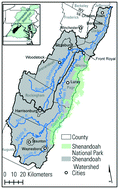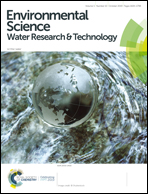De facto reuse and disinfection by-products in drinking water systems in the Shenandoah River watershed†
Abstract
De facto reuse is increasingly being studied among the variety of stressors that are relevant to drinking water systems that obtain their source water from surface waters. De facto reuse may influence the levels and types of precursors relevant to formation of disinfection by-products (DBPs) in surface water systems. DBPs such as trihalomethanes (THMs) and haloacetic acids (HAAs) have been associated with bladder cancer and other health concerns in people who use drinking water provided by public water systems (PWSs). In this study, we used compliance monitoring data from conventional surface water PWSs in the Shenandoah River watershed to evaluate the relationship between de facto reuse in the watershed with DBP formation in those systems. The Shenandoah River watershed was selected for this study because it has a relatively small group of PWSs that draw their source water from surface waters in the watershed, the majority of whom treat their water using chlorine, and are less likely to have confounding factors (such as complex distribution systems or lengthy residence times) than other watersheds. We found that concentrations of THM4 and HAA5 increase in drinking water systems as de facto reuse increases in their source waters and that the relation is observed at both annual average and low streamflow conditions (annual average and low streamflow increases were statistically significant for THM4 with p values of 0.027 and 0,021, respectively). In addition, using a t-test, we found that a 1% level of de facto reuse was associated with significantly higher levels of THM4 and HAA5 (p < 0.05) under annual average streamflow conditions. While the concentrations of HAA5 were also higher under annual average and low streamflow conditions, we did not find that they achieved a level of a significant difference. Results from this research will be helpful to operators of PWSs and other researchers and stakeholders with an interest in water reuse and DBPs.



 Please wait while we load your content...
Please wait while we load your content...